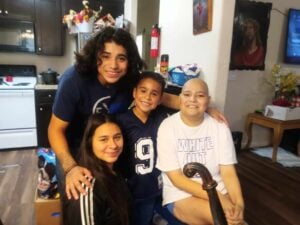
Sights Set on a Strong End to 2023 — Will You Join Us?
Family Reach CEO Carla Tardif reflects on 2023 and calls for community support before the year ends.
The cost of oil is slowly falling, but high prices at the pump are still disrupting cancer patients’ and caregivers’ access to care.
An empty tank of gas should never be the reason a family doesn’t make it to cancer treatment.
Imagine driving along and being afraid to look at the gas gauge because you know the red warning light is about to come on and you’re nowhere near the treatment center. Racing through your brain is an impossible question: Do you spend the last dollars in your bank account on gas or dinner for your family that night?
These are the stories we hear all the time at Family Reach. For families facing cancer, getting from point A to point B can come with a multitude of roadblocks.
Gas prices, which peaked in June 2022 at $5.03 a gallon1, are just one of many recent cost increases adding to the financial barriers that can prevent families from accessing life-saving treatment.
When 6-year-old Mary was diagnosed with cancer almost two years ago, her parents, Robert and Kristin sought the best treatment and Kristin adjusted her work hours to care for her daughter. Then the couple was blindsided by another crisis: the financial impact of a cancer diagnosis.
Paired with new out-of-pocket expenses and the sudden loss in Kristin’s income, everyday costs like housing, food, and transportation quickly added up for this family and have shown no signs of slowing down.

Nearly 40% of the families Family Reach supports report traveling 50 miles or more to treatment. When oil prices rise, so do the expenses these families must incur as they head to the hospital day after day, week after week, to access life-saving care.
For Mary’s parents, recent increases at the pump have nearly tripled their care-related travel expenses.
“We travel from our home in Denver, Colorado, to Palo Alto, California, every six-to-eight weeks for Mary’s treatment,” Kristin explained. “In between those visits, we have three follow-up appointments a week at our local hospital in Denver, which is a 60-mile roundtrip commute. The rising cost of fuel has caused the amount we pay for airfare and gas to jump from $2,000 a month to $6,000. It’s been devastating.”
While the cost of oil is slowly decreasing, prices remain high and Kristin’s challenges are not unique. Between July 2021 and June 2022, Family Reach saw a 58% increase in the amount of emergency relief provided to cover transportation-specific costs. This jump drastically underscores the severity of the situation, which is compounded by increases in other everyday costs like groceries, electricity, and housing.
Families facing cancer are being forced to choose — do they put gas in their car or buy groceries? Do they pay the mortgage or buy an airplane ticket to treatment? As they make these devastating decisions and fall deeper and deeper into debt, their chances of a positive cancer outcome begin to diminish. In fact, patients who file for bankruptcy have a 79% greater risk of early mortality.2
Parents, spouses, children, siblings, friends — there are people behind the cancer diagnosis. A parent is always going to get their child to treatment before meeting their own basic needs — and if they’re the patient, they might skip their own treatment to make sure their family has food on the table. Here at Family Reach, we believe everyone deserves both.
Like Kristin, Graciela is the mother of a child with cancer. She, too, has racked up miles to get her daughter to treatment — including twice-weekly blood monitoring appointments and daily radiation — this summer.

“I was able to cover one month of gas expenses with the support I received from Family Reach,” Graciela said. “In times like this, that support is huge — gas expenses end up putting us in the negative, so it was a relief not worrying about how we would get Camila to treatment.”
The oil crisis is turning a corner, but its effects on cancer patients and caregivers still linger. In 2021, Family Reach was able to help 1,618 families with travel-related costs alone, and we expect that number to increase in 2022 as demand for our services increases.
Families are struggling to make ends meet, and it’s jeopardizing their loved one’s chances of survival. Will you join us in removing financial barriers like these for cancer patients nationwide?
Resources

Running enthusiast, patient advocate, and CEO of Family Reach, Carla Tardif is a spirited leader who isn’t afraid to go the distance. She’s been leading the charge against the financial burden of cancer for over 15 years, making tangible impacts for cancer patients and their families through innovative solutions and collaboration.

Family Reach CEO Carla Tardif reflects on 2023 and calls for community support before the year ends.

Your holiday giving provides financial relief to families like these who are facing cancer this winter.

Curious what a donation to Family Reach does? Here’s a breakdown of how donations to Family Reach provide financial support to families facing cancer.
Applications will only be reviewed and processed for open funds.
Applications will only be reviewed and processed for open funds.
Applications will only be reviewed and processed for open funds.
Applications will only be reviewed and processed for open funds.
Applications will only be reviewed and processed for open funds.
Join our email list for updates about our events, fundraising campaigns, family stories, partnerships, and the impact of your generous support.